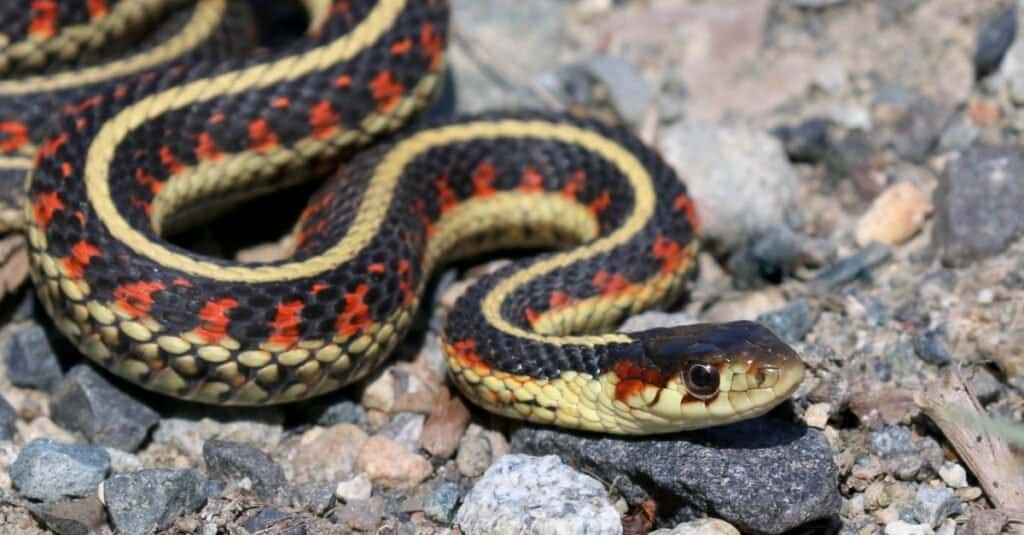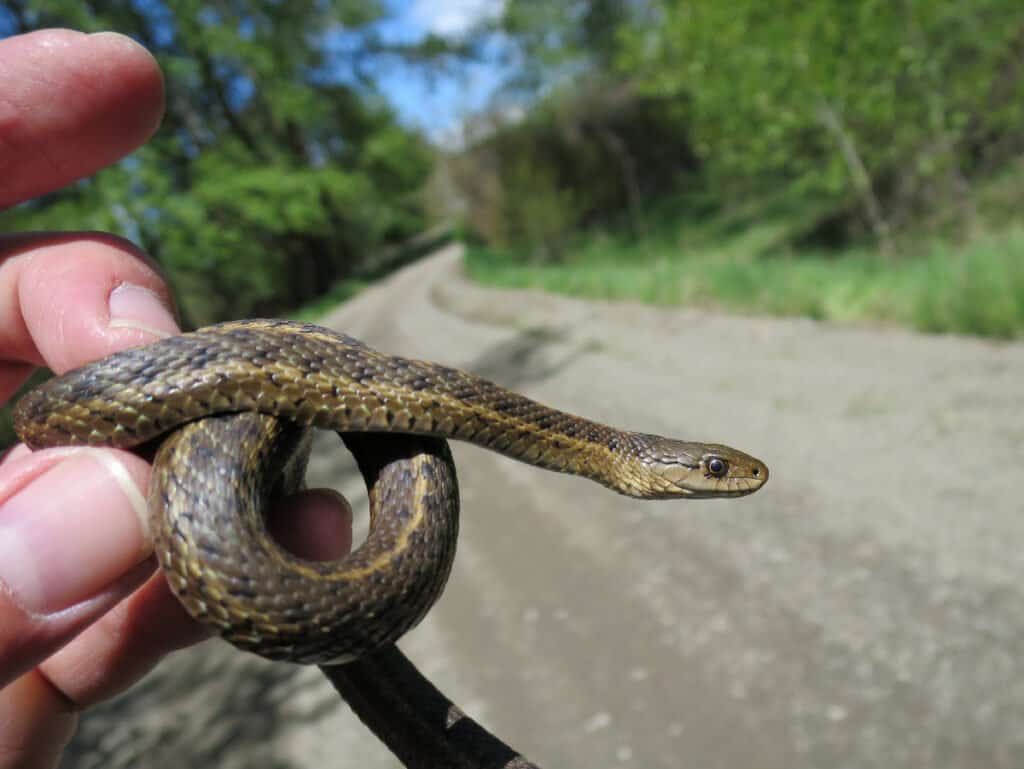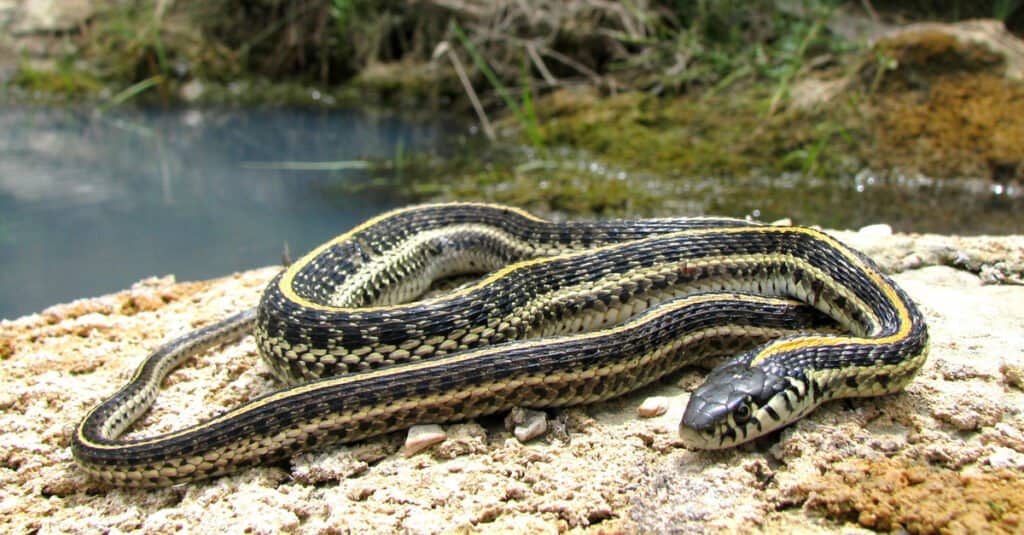From the Rocky Mountains to the Great Plains and the expansive wilderness of Glacier National Park, the landscape of Montana is wild and diverse. Much of the state is sparsely populated, with many ‘frontier’ counties that have fewer than six residents per square mile. With so much untamed land, it’s no surprise that Montana is home to abundant wildlife, including snakes. Out of the 10 snake species native to Montana, 3 are nonvenomous garter snakes. In fact, only one snake in Montana is venomous, and that’s the prairie rattlesnake. Let’s take a detailed look at the garter snakes in Montana. Which garter snake species live there?
Get Familiar with the Garter Snake
Garter snakes eat insects, slugs, rodents, and other small prey, so they can be a welcome garden companion. They help to keep common pests at bay and prefer to stay mostly out of sight. Although their saliva is toxic to their prey, they don’t have venom that’s harmful to humans. The garter snake sometimes called a grass snake, is part of the Natricinnae subfamily. Like most in this group, they are ovoviviparous and give birth to live young. Their genus Thamnophis includes about 35 garter snake species. The name is derived from the Greek words thamnos, meaning ‘bush or shrub,’ and ophio, which means ‘snake.’
Native to North America, the common garter snake species name is Thamnophis sirtalis. Sirtalis is Latin for “like a garter.” It likely refers to their similarity in appearance to old-fashioned sock garters. The common garter snake is further divided into 13 recognized subspecies, such as the valley garter snake. Let’s find out if you can find the common garter snake in Montana and what other species might be spotted there.
Garter Snakes in Montana

In Montana, you can find garter snakes in forested areas, open fields, grasslands, wetlands, and marshes.
©VIKVAD/Shutterstock.com
Like all snakes, garter snakes are ectotherms, meaning that they regulate their body temperature by either absorbing or giving off heat. Since their temperature depends entirely on environmental conditions, you might find garter snakes in the shade during the heat of the day or sunning themselves on rocks when they need to warm up. They’re often attracted to the heat that radiates from paved roads.
You can find garter snakes in forested areas, open fields, grasslands, wetland borders, and marshes. While you’re most likely to find them in your backyard in the summertime, they often show up in basements in autumn. Garter snakes go into a period of inactivity called brumation during the cold winter months. They usually brumate in crevices under rocks, in trees, or on the banks of streams. As they seek out their site to bed down while the weather’s cold, they’ll sometimes find their way into buildings, and it can be hard for them to find their way back out. As is the case in many states, garter snakes are the most commonly seen snakes in Montana.
Which Garter Snake Species Live in Montana?
This state is home to three species of garter snake: the common, terrestrial, and plains garter snake.
Common Garter Snake (Thamnophis sirtalis)

The common garter snake is widespread throughout Montana.
©iStock.com/randimal
The common garter snake is widespread throughout Montana, aside from a small strip along the northeast portion of the state. You can find it in woods, fields, brush, and brush piles. Like most garters, they’re most common at low elevations near water sources. While the sight of a snake may catch you by surprise, there’s no reason to fear these snakes. If picked up, they may secret a musk as a deterrent or even bite, but their bites aren’t harmful to humans. They grow to be 16 to 42 inches in length with a thin body. Common garter snakes present two color variations in Montana. One has three yellow stripes that run the length of its body on a black background with red spots running between the stripes. The other variation shows the same striping but without red dots. In both, the belly is yellow to bluish.
A study in the Intermountain Journal of Sciences finds that the common garter snakes in Montana exhibit characteristics of two subspecies: the valley garter snake (Thamnophis sirtalis fitchi) and the red-sided garter snake (Thamnophis sirtalis parietalis).
Western Terrestrial Garter Snake (Thamnophis elegans)

The western terrestrial garter snake is unique in its tendency to constrict prey
©Randy Bjorklund/Shutterstock.com
The western terrestrial garter snake lives all over Montana, except for a small square of the Northeast. It’s similar to the common garter snake in appearance. It grows to a similar body length of 16 to 43 inches. It also has three yellow stripes running the length of its body but has a series of black spots between or on the stripes. The background body color of these snakes is brown or greenish. Sometimes you might see an all-black western terrestrial garter snake. Dark brown or black blotches cover their belly. Like all garter snakes, this species has saliva that contains venom that’s mildly toxic to subdue its prey for easier ingestion. However, this type of garter snake is unique in its tendency to constrict its prey. It is the only garter snake species that engage in constriction to feed.
The subspecies of the western terrestrial garter snake found in Montana is called the wandering garter snake (Thamnophis elegans vagrans).
Plains Garter Snake (Thamnophis radix)

The plains garter snake is even less likely than the common garter to bite when handled.
©Joe Farah/Shutterstock.com
The plains garter snake is one of the most cold-tolerant snakes. It will often emerge from brumation to bask on warm, sunny days. You can find the plains garter snake in the central and eastern portions of Montana, east of the Rocky Mountains. They like open spaces like farm fields, yards, and parks, and like most garters, they prefer to be near water. Similar to both other species found in this state, the plains garter snake grows to be 16 to 42 inches in length. They have olive green, brown or black bodies with an orange or yellow dorsal stripe down the back. They also have two greenish-yellow stripes on each side of their body. It has unique black bars around its mouth. Although no garter snakes pose a threat to humans, this species is particularly docile and is less likely than the common garter snake to bite when handled.
The photo featured at the top of this post is © iStock.com/randimal
Discover the "Monster" Snake 5X Bigger than an Anaconda
Every day A-Z Animals sends out some of the most incredible facts in the world from our free newsletter. Want to discover the 10 most beautiful snakes in the world, a "snake island" where you're never more than 3 feet from danger, or a "monster" snake 5X larger than an anaconda? Then sign up right now and you'll start receiving our daily newsletter absolutely free.
Thank you for reading! Have some feedback for us? Contact the AZ Animals editorial team.






